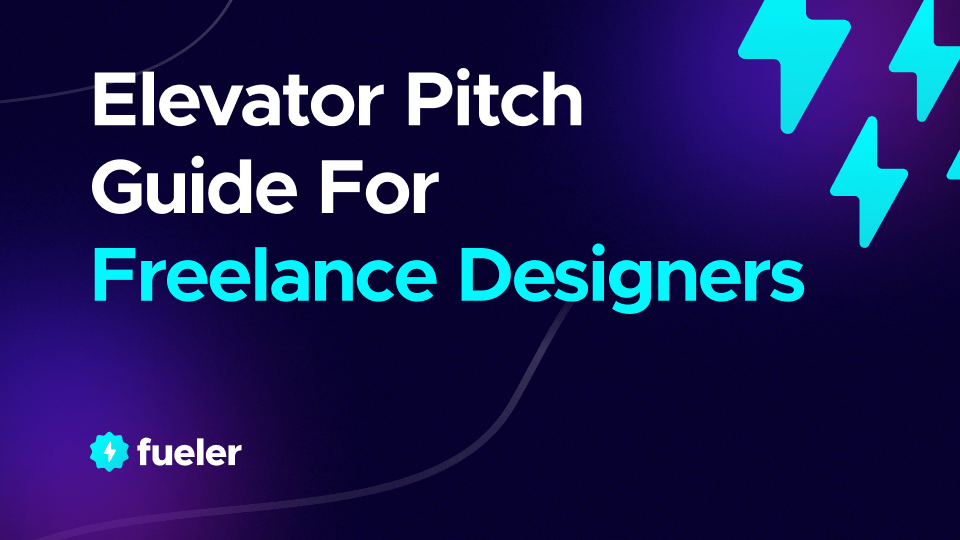Graphic Design Elevator Pitch Guide For Freelance Designers

Team Fueler
16 Aug, 2024

An elevator pitch is your chance to wow a potential client and secure your next graphic design project. In 30 seconds, you want to convince them that you’re the right person for the job. You want to be short, sharp and memorable.
However, condensing a career’s worth of design experience into a single elevator pitch can be a daunting task. If you’re unsure about how to deliver an elevator pitch that gives you the best possible chance of securing design work, you’ve come to the right place. In this article, we’ll go over why elevator pitches are so important and how you can best deliver one to a potential client.
Prompt & Presentable: The Keys to a Successful Elevator Pitch
When delivering an elevator pitch, you want to say your piece in around three sentences. This is not the time to give a full rundown of your experience or answer all potential questions. Focus on telling a potential client what makes you valuable. This might be a rare skill you possess or experience in a similar project to the one your client wants completed.
The goal of your elevator pitch is to pique a potential client’s interest enough for them to be willing to sit down with you for a longer period of time. Remember to be concise, clear and memorable.
And speaking of memorable, it’s also worth noting that presentation matters. If you’re delivering your pitch with the help of an infographic or examples of your work, you’ll want to make sure these supporting resources are well-presented, with no pixelation and no typos. A tool that allows you to convert JPEGs to PDFs can be extremely helpful here, as you can provide potential employers with higher-quality infographics that are easily sent via email or downloaded across Macs, Windows, and even Apple or Android phones, as PDFs are a universally accepted file type.
Why Do You Need an Elevator Pitch?
Usually, potential clients won’t give you the time to go through your CV in extensive detail. They’re often incredibly busy and will have no shortage of applicants looking for design work. An elevator pitch presentation gives a potential client a broad overview of the unique value you can provide them.
It’s also useful to have an elevator pitch handy at any time, as you never know when opportunities might arise. You might be having a conversation with a friend of a friend who mentions that they’re looking for a designer, or even find yourself in a literal elevator with a potential client to whom you can pitch your services. If you catch their attention, you'll be able to schedule a meeting where you can prepare an investor pitch deck and have more time to present your company or ideas.
How to Craft Your Elevator Pitch: 7 Tips
An elevator pitch might last thirty seconds, but creating one takes much longer. Here are some specific tips to help you design an amazing pitch that is sure to secure you plenty of design work, whether you’re a budding graphic designer or a seasoned professional.
1. Find Your Value
The person to whom you’re pitching probably has no shortage of applicants looking for graphic design work. Within the space of a 30-second elevator pitch, you want to lay out what sets you apart from the crowd. Because of your limited time, stick to the essentials: highlight your most unique skills and experiences, provided that they’re relevant to the project.
2. Know Your Audience
Know who you’re pitching to. Prior to making an elevator pitch, take the time to understand who your client is and what they need. For instance, an executive from a large consulting firm will have different expectations of a graphic designer than a restaurant manager would. Adjust your pitch based on what you think would be most appealing to them.
3. Don’t Assume Prior Knowledge
It’s always safest to assume that your potential client knows nothing about graphic design. Lay out your skills and experience in words that anyone can understand and avoid industry jargon. If you do have to use technical terms, dedicate a few seconds to explaining what they mean.
4. Prove Your Expertise
It’s easy to say you’re the best graphic designer in the world, but these words mean nothing without evidence. During your elevator pitch, you want to highlight key experiences that prove you’re the best person for the job. Where possible, use numbers to back up your claims. For instance, your ad visual might have led to a 30% increase in click-through rate. You’re speaking with business owners and business owners make all decisions based on their bottom line, so don’t be afraid to use your own figures to back up your passion and competency.
You can use your design portfolio to highlight your best projects, this helps you build insane credibility as a professional.
5. Be Passionate & Conversational
A pitch shouldn’t come off as a stilted, formal speech. Remember that you’re speaking to human beings, and tailor your elevator pitch based on your potential client’s personality. As much as possible, stick to everyday language. If you can, spend some time getting to know them prior to making your elevator pitch. Above all, make your potential client feel comfortable.
6. Be Bold & Memorable
If you’ve ever done a group interview, then you know just how vital it is to be bold in order to stand out. Approach your elevator pitch with that same mentality – you need to ensure that you and your presentation stands out from the hundred others your potential client has probably already listened to. If you can, do this by highlighting particularly impressive skills or achievements. You can also use humour, fun facts or a unique delivery style to set yourself apart from your competitors. Incorporating a QR code from The QR Code generator in your pitch materials can also make a strong impression, providing a quick and interactive way for clients to engage with your content.
7. Practice & Improve Constantly
Not all pitches go off perfectly. In fact, it’s likely you’ll have a few that are absolute disasters. Don’t be discouraged: use failure as a learning opportunity to improve your elevator pitch in the future. You also shouldn’t neglect consistent practice. While you want your pitch to seem effortless, you’ll need to use some best graphic design tool and put lots of work in if you want to achieve this effect.
An elevator pitch can be a scary proposition. However, the strategies we’ve gone over in this article can help you create and deliver one that gives you a great chance of landing that dream graphic design gig.
Start applying these tips to your elevator pitches, and you’ll see an uptick in freelance offers in no time. What are you waiting for? Go out there and pitch.
Fueler is a career portfolio platform that helps companies find the best talents for their organization based on their proof of work.
You can create your portfolio on Fueler, thousands of freelancers around the use Fueler to create their professional-looking portfolios and become financially independent. Discover inspiration for your portfolio
Sign up for free on Fueler or get in touch to learn more.


